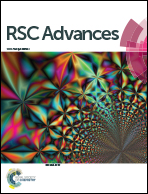Preparation, characterization and long-term antibacterial activity of Ag–poly(dopamine)–TiO2 nanotube composites
Abstract
A simple and efficient approach for the loading of Ag nanoparticles on poly(dopamine)-modified TiO2 nanotubes (PDA–TNTs) was used to prepare a Ag nanoparticle–poly(dopamine)–TiO2 nanotube composite (Ag–PDA–TNTs) that was applied as a long-term antibacterial agent to inhibit the growth of bacterial cells. The features of the obtained Ag–PDA–TNTs were investigated by TEM, XRD, FT-IR and XPS analysis. Anatase TNTs were encapsulated in PDA layers with a thickness of about 3 nm on which about 20.4 wt% of single crystalline Ag nanoparticles anchored. XPS and FT-IR results indicated that the PDA layer not only served as a reduction reagent that could reduce Ag+ ions to Ag nanoparticles but also worked as an adhesive coating by tethering the Ag nanoparticles on the surface of PDA–TNTs. The long-term release profiles of the nanocomposites showed that PDA layers slowed the release rate of Ag nanoparticles, implying the possible long-term antibacterial activity of Ag–PDA–TNTs; and the antibacterial assays verified this point. Besides that, the antibacterial activity of Ag–PDA–TNTs under visible light was higher than that in the dark because of the synergistically antibacterial effects of Ag nanoparticles and ROS under visible light irradiation. Compared with the antibacterial activity of TiO2 nanotubes loaded with Ag nanoparticles (Ag–TNTs), Ag–PDA–TNTs had higher and longer-term antibacterial activity which is attributed to the effect of PDA layers tethering Ag nanoparticles on TNTs and slowing Ag+ ions release rate. This work provides a new method for the preparation of Ag-based antibacterial agents and facilitates their practical application in modern antifouling and biomedical fields.


 Please wait while we load your content...
Please wait while we load your content...